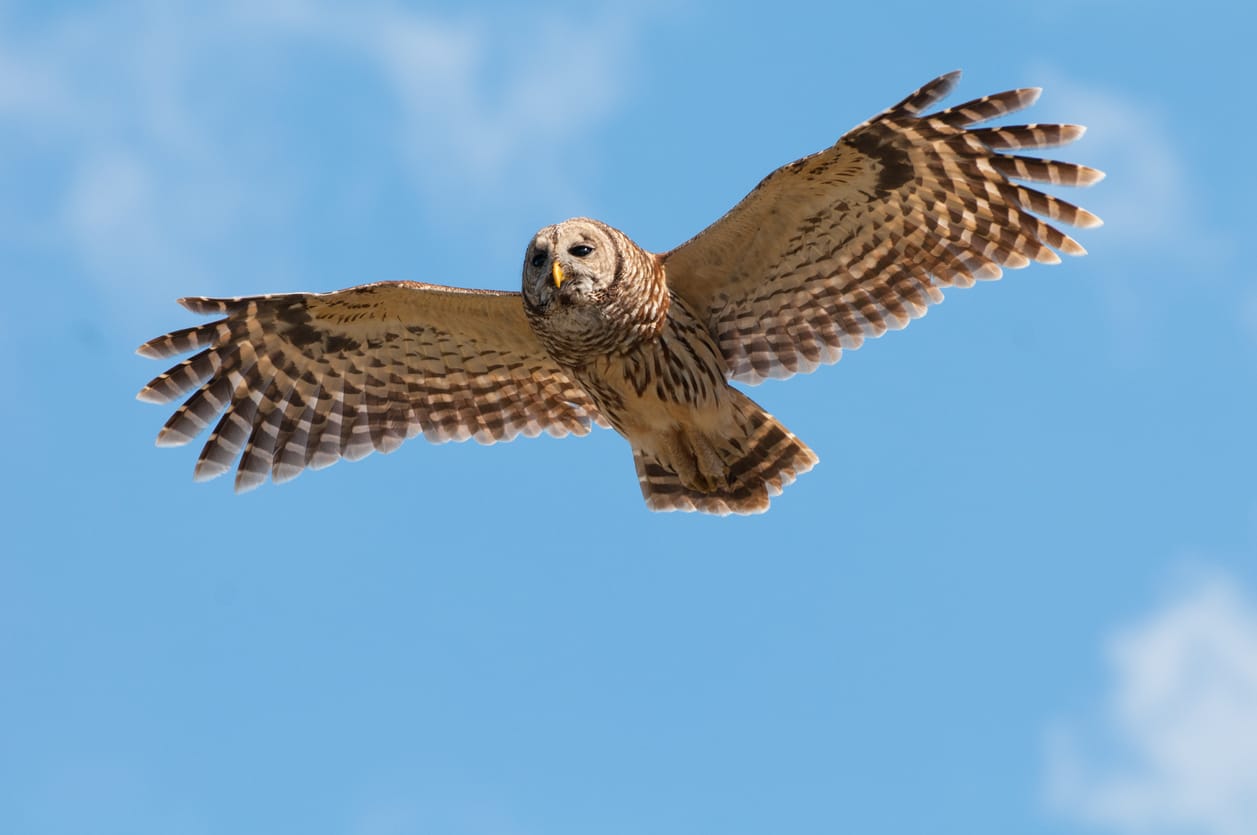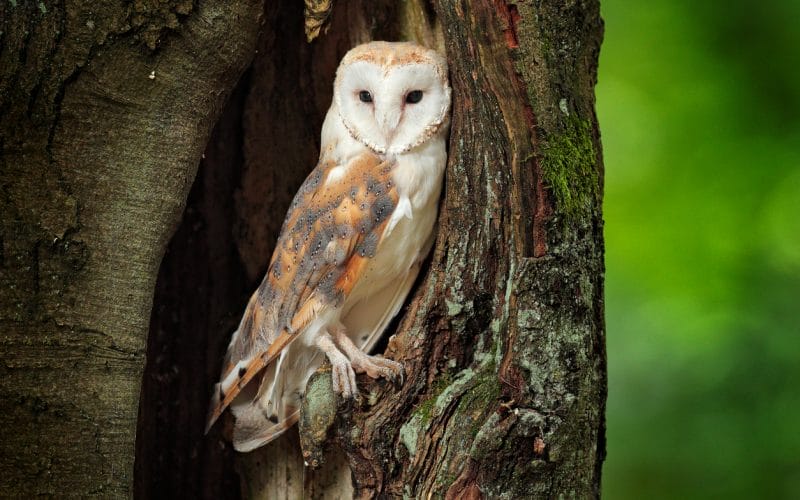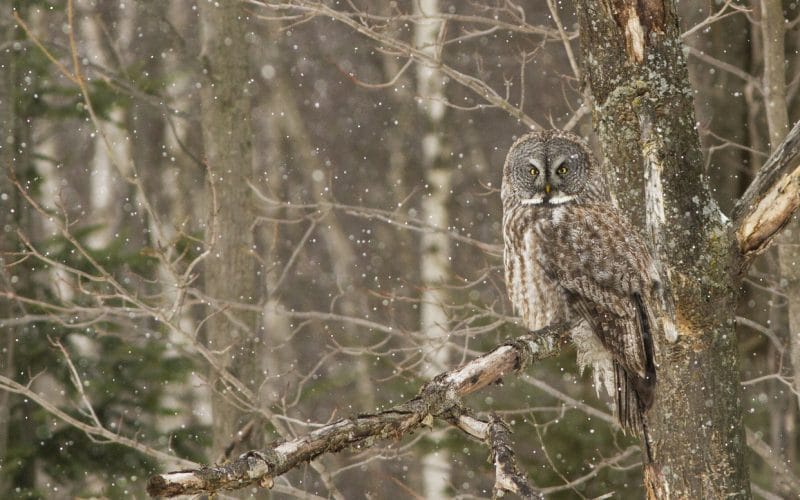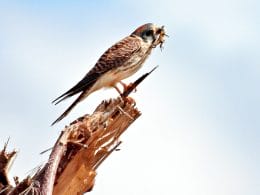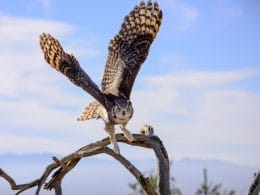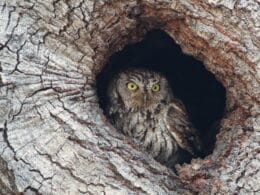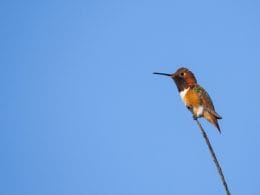Ohio provides the perfect habitat for predatory birds, thanks to its vast forestlands and 40,000 miles of water streams. That’s why bird-watching is a must if you’re staying in the Buckeye State for a while.
Out of the 400 bird species that live in Ohio, there are eight owl breeds you may like to see during your time in the state. Some of them stay in the state for the whole year, and some only pass through it during their migration season.
In all cases, you’re bound to see a lot of owls during your visit to the state.
Here’s a complete roundup of everything you may want to know about the eight species of owls in Ohio.
The 8 Species of Owls in Ohio
There’s a nice variety of owls in Ohio. Although there are only eight species, they all have different living styles and feeding habits. Read on to find out more about how each species lives in Ohio.
1. Barn Owl

- Scientific Name: Tyto furcata
- Length: 13–15 inches
- Weight: 1–1.3 pounds
- Wingspan: 42–43.3 inches
Barn Owls are widespread in all the US, so it’s no wonder their populations are large in Ohio too. Although the species is classified as endangered in the Buckeye state, some counties have abundant numbers.
Author Note: Barn Owls are otherwise called ghost owls because of their hunting habits. They watch their prey silently, then swoop down on it without warning. Other theories have it that the name comes from how their white faces look in the night.
These owls mostly live in abandoned barns and under bridges, explaining their name. They hide their nests, so it’s hard to locate them. Not only that, but they’re also strictly nocturnal, rarely making an appearance when the sun is out.
The main threat to Barn Owls in Ohio is their fellow species, Great Horned owls.
Because of the size difference, Horned owls regularly feed on Barn Owls and smaller species. Other than that, they’re not at much risk of being hunted.
2. Eastern Screech-Owl

- Scientific Name: Megascops asio
- Length: 6.3–9.8 inches
- Weight: 4.2–8.6 oz
- Wingspan: 18–24 inches
The Eastern Screech-Owl is common in most states, and its numbers are abundant in Ohio. It stays in the state for the whole year, so you have a good chance of catching it.
Contrary to most species, Eastern Screeches are on the smaller side. In fact, they may be considered tiny compared to large species like Great Horned Owls. They use their size to their advantage when they blend in with other birds, looking for food.
Despite their misleading name, Eastern Screeches don’t regularly screech. They only do it when they’re in danger, or there’s a threat to their nest. The other times, they stick to quavering and lowly hooting.
If you have nesting boxes in your backyard, you may find a couple of Eastern Screech-Owls someday.
They’re known for accepting nesting boxes whenever they see them. If you’re lucky enough, you may catch them during their mating season and catch a male doing the remarkable dance!
Although Eastern Screech-Owls are seemingly cute, I can’t say the same about their feeding habits. Usually, they feed on small birds, bats, and small rodents and animals. However, when they can’t find enough food, their cannibalistic traits are revealed.
They tend to eat their own kind, usually targeting the smaller fledglings.
3. Northern Saw-whet Owl

- Scientific Name: Aegolius acadicus
- Length: 7–8.3 inches
- Weight: 2.3–5.5 oz
- Wingspan: 16.5–19 inches
Northern Saw-whets are the smallest owl species in Ohio and the United States, giving them a spot in the middle of the food chain. They’re often fed on by other species, most famously Great Horned Owls.
However, their wings spread out widely when they’re in flight, tricking their prey to think they’re larger than they actually are.
Plus, although they’re predatory birds, Northern Saw-whets are adorable. They have wide, innocent eyes, and their tiny bodies aren’t scary. However, that doesn’t make them any less aggressive than other owl species.
These fellows are avid hunters. They only hunt at night, staying on a low perch and watching their prey silently. You may think hunting at night is hard, but not for owls.
Author Note: They have tube-shaped eyes with a lot of rods, making them highly sensitive to light. They can receive the tiniest amount of light, and their irises will widen to allow it in.
Northern Saw-whets are mostly reclusive, preferring to stay alone. They choose nesting areas near forests, and they feed on songbirds, rodents, and insects. When food is scarce, they feed on other small owls.
4. Short-eared Owl

- Scientific Name: Asio flammeus
- Length: 13–17 inches
- Weight: 7.3–16.8 ounces
- Wingspan: 33.5–40.5 inches
In Ohio, you can catchShort-eared Owls in the Northwestern region. That’s where the breeding pairs are. The rest of the state will have non-breeding owls, so you won’t see them all year long.
They’ll be most abundant from November to March, outside of their breeding season.
Short-eared owls have tufts on top of their heads, but they’re tiny, hence the naming. You won’t be able to see them except if you look close enough. So, instead, you may identify the birds with their bright yellow eyes and white brackets surrounding their faces.
Unlike most owl species, Short-eared Owls aren’t strictly nocturnal. They still hunt at night, but they make appearances throughout the day as well. Their most active hours are at dusk and dawn.
Although Short-eared Owls are mid-sized, they’re still aggressive.
They’re known for their violent feeding habits. Before swallowing their prey, they decapitate it, removing its head and wings before throwing it down their mouths.
5. Long-eared Owl
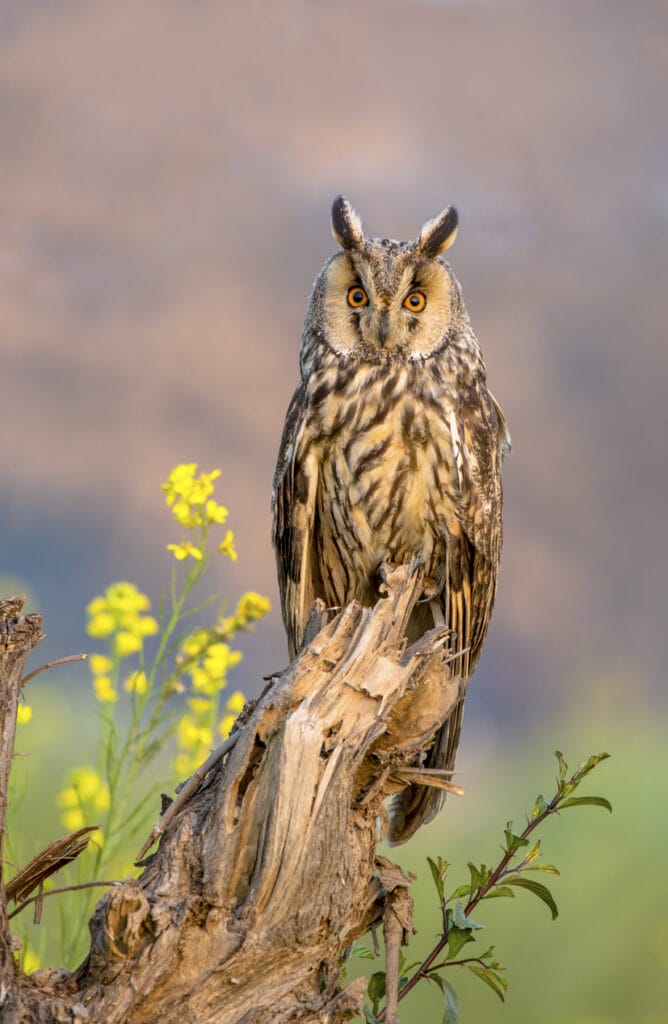
- Scientific Name: Asio otus
- Length: 13.8–15.8 inches
- Weight: 7.8–15.5 ounces
- Wingspan: 35.5–39.5 inches
Long-eared Owls have that name because they have apparent tufts on their heads—similar to the ones on Great Horned Owls. Although they’re not large among other species, they’re known for their bullying instincts.
When they turn up on a backyard feeder or a nest, they scare the other birds away and steal their food. They also hate to build their own nests, so they mostly resort to stealing the ones that are already created by magpies, hawks, or ravens.
Other than the distinctive tufts, long-eared owls have catlike features with hollowed-out sides. You’ll find it easy to identify them once your sight falls on them. If you can’t see them, you may strain your ears for their loud hoots.
Male Long-eared Owls have loud calls; they sound like they’re squealing, and you can hear it up to one kilometer away.
Most Long-eared Owls live and breed in Northeastern Ohio. There are other owls spread throughout the state, but they’re out of their breeding range.
6. Great Horned Owl

- Scientific Name: Bubo virginianus
- Length: 17–25 inches
- Weight: 2.5–4 pounds
- Wingspan: 36–60 inches
Great Horned Owls are scary, mystical, and unique. They have a fiery aura around them, making them look like special creatures from ancient horror movies. And although I wouldn’t say Great Horned Owls belong in horror movies, it wouldn’t be far from their scary nature.
The first thing you’ll notice on these owls is their yellow, intense eyes. They’re round and don’t move, giving you the impression that they’re fixated on one place.
Having said that, it’s true that they don’t move because they’re not eyeballs. For these owls to see in different directions, they have to turn their heads.
Top Tip: Aside from the eyes, Great Horned Owls have tufts on top of their heads that look like a devil’s horns. That explains their odd name.
In Ohio, you’ll see Great Horned Owls around all year long. They rarely leave the state, and their numbers are abundant.
These owls are larger than average, being the second-largest owls in the state. They’re also classified as the most aggressive species in the US. They’ll feed on fellow owls without batting an eye.
If you want a chance to see Great Horned Owls, look for them near swamps and open woodlands. They’re nocturnal, though, so your chances of seeing them during the day are slim.
7. Barred Owl

- Scientific Name: Strix varia
- Length: 16–25 inches
- Weight: 1–2.75 pounds
- Wingspan: 38–49 inches
Barred Owls are the center of many owl myths, and it’s not hard to see why. With their large bodies, hollowed-out faces, and charcoal black eyes, these owls are made to be feared. That’s why they’re classified among the most dangerous birds to ever exist.
They’re common in Ohio’s woods, and they’re nocturnal like most owls species. However, they’re hard to see because they camouflage well against trees. Their barred bodies with streaks of white and brown make them look like parts of the nature around them.
Because these owls are large, they maintain a spot on the top of the food chain. In other words, they’re rarely fed on, except by Great Horned Owls. Other than that, their only predators are humans with hunting rifles.
Barred Owls are much larger than Barn Owls, but their size doesn’t protect them from their much larger enemy, the Great Horned Owl. These large, scary owls can feed on an entire population of barred owls.
Barred Owls have a distinctive call that sounds like repetitions of ‘who cooks for you.’ You’ll often hear them before you see them because of their vocal nature. If they see you, they’re likely to stay in their place and watch you curiously, unless you show some kind of threat.
8. Snowy Owl

- Scientific Name: Bubo scandiacus
- Length: 20.7–25 inches
- Weight: 3.3–4 pounds
- Wingspan: 47–60 inches
Snowy Owls are as vicious as they come. Never mind their angelic white bodies or innocent faces; these champs will kill ruthlessly without a hint of remorse. They’re classified among the most dangerous birds in the world, rightfully so.
In Ohio, you can see Snowy Owls in the Northern regions. They have been spotted frequently on Lake Erie’s shares. Their wings spread to reach a length of five feet, so they shouldn’t be too hard to identify.
Author Note: Snowy Owls depend on two things for hunting: their color and their silence. Since they mostly live in arctic areas, they know their white color will hide them. So, they camouflage against the snow while looking for prey.
Not only that, but Snowy Owls are also eerily silent. They have feathers with fringed edges, swallowing the sound of flapping. So they’re perfectly capable of flying without making any noise.
They give their prey a false sense of victory, then they close in on the unsuspecting animal and steal it before it knows what’s hitting.
What Other Birds Can You Spot in Ohio?
Aside from owls, there’s a nice variety of birds you can spot in Ohio. You can see the Summer Tanager with its bright red body. It breeds in Northern Ohio, and it stays in the state all year long. Other red birds in the state include the Northern cardinal and the red-winged blackbird.
There are also Indigo buntings with their deep blue bodies. You can spot these small birds perching on telephone lines.
If you love watching hummingbirds with their iridescent feathers, look out for Anne’s hummingbirds in Ohio. They’re not common in the state, but there have been some sightings.
If you can’t find them, look for their close cousins: Calliope’s hummingbirds. Or, look for Rufous hummingbirds; they, too, are common in Ohio.
Moreover, ruddy ducks are highly common in Ohio, particularly in Lake Erie and on its shores.
On your pursuit to spot owls, don’t forget to watch out for these birds as well.
Closing Thoughts
There aren’t many species of owls in Ohio, but the eight species are worthy of your trip. If you’re lucky, you can see a rare snowy owl in all its glory.
Other than that, you’re bound to see Barn Owls or Great Horned Owls, seeing as their numbers in the state are on the rise.
FAQ
To find out where recent sightings of owls have been, try eBird. You can search for the latest sightings or particular species or what has been seen in a certain area.
The Eastern Screech-Owl and the Barred Owl are the most common owls in Ohio.
Audubon recommends all the following places to see owls: Killdeer Plains Wildlife Area, Oak Openings Preserve Metropark, Buck Creek State Park, Green Lawn Cemetery and Arboretum, Edge of Appalachian Nature Preserve, Fernald Preserve.




